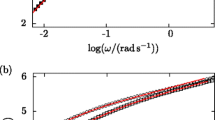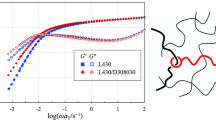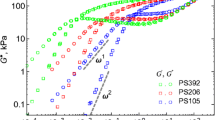Abstract
The viscoelasticity of unentangled polystyrene melts has been investigated in terms of terminals parameters: zero-shear viscosity, steady-state compliance and relaxation spectrum. The Rouse model applies well for molecular weights lower than the average molecular weight between entanglements, providing that one takes into account the proper variations of the radius of gyration. Moreover, local motions at the scale of Kuhn segments have to be considered in order to describe correctly the relaxation modes intermediate between the terminal zone and the glassy plateau.
On the other hand, reptation models are commonly used for describing the entangled regime. We propose an expression of the shear modulus which accounts not only for the terminal modes (reptation, tube length fluctuations and tube renewal), but also for the relaxation modes responsible for the plateau zone and the transition of the glassy plateau. A crossover region between the unentangled and untangled regimes is located around . When the molecular weight increases, a shift transfer of Rouse modes towards reptation modes occurs. That leads to a continuity of the expression of the shear modulus over the entire range of molecular weights.
Similar content being viewed by others
Author information
Authors and Affiliations
Additional information
Received: 29 December 1997 Accepted: 27 July 1998
Rights and permissions
About this article
Cite this article
Majeste, JC., Montfort, JP., Allal, A. et al. Viscoelasticity of low molecular weight polymers and the transition to the entangled regime. Rheol. Acta 37, 486–499 (1998). https://doi.org/10.1007/s003970050135
Issue Date:
DOI: https://doi.org/10.1007/s003970050135




